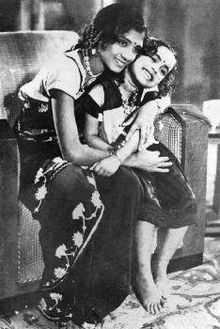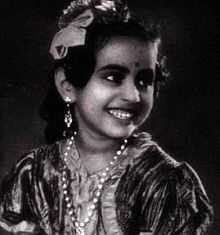Balayogini
| Balayogini | |
|---|---|
 K.R. Chellam and Baby Saroja in Balayogini | |
| Directed by | K. Subramanyam |
| Produced by | K. Subramanyam, Madras United Artists Corp |
| Written by | K. Subramanyam |
| Starring |
Baby Saroja C. V. V. Panthulu K. B. Vatsal R. Balasaraswathi |
| Music by |
Moti Babu Maruti Seetharammayya |
| Cinematography |
Sailen Bose Kamal Ghosh |
| Edited by | Dharam Veer |
Release dates | 5 February 1937 |
Running time | 210 min. |
| Country | India |
| Language | Tamil |
Balayogini (Tamil: பாலயோகினி; Telugu: బాలయోగిని) is a 1937 film made in Tamil and Telugu. It was directed by K. Subramanyam. It is one of the earliest Tamil films to be set in a contemporary social setting and to advocate reformist social policies. This film is considered to be first children's film of South India.[1][2][3][4][5]
Production
Subramanyam, was influenced by the reformist ideals of his father C.V. Krishnaswamy Iyer. He was moved by the social conditions around him to make reform oriented films. Balayogini (lit. Child Saint) was made to expose the plight and suffering of widows in middle class Brahmin communities in Tamil Nadu. Subramanyam produced this film under his "Madras United Artists Corporation" banner to express his criticism of the existing social norms and his disapproval of priesthood.[3][6] He wrote the story, screenplay & dialogues and directed it himself. He cast his niece Saroja as the titular character. The film was started in 1936 and released in 1937. The completed film was 19,000 feet (210 minutes runtime) in length.[7]
Telugu film
It was remade in Telugu with dialogues written by B.T. Raghavacharya, under the banner of Mahalakshmi Studios.[8] Baby Saroja, played the key role of Widow's Daughter and the other main characters are played by Arani Satyanarayana, Vangara, Kamala Kumari, Thilakam and S. Varalakshmi.
Plot
Sarasa's (K. R. Chellam) father is arrested by Police for being a debtor. She goes to the sub collector's (K. B. Vatsal) house to ask for help. The collector's widowed sister Janaki and her niece (Baby Saroja) take pity on her. They are driven out of the house by the angry collector. They take refuge in the house of their low-caste servant Munuswamy. Munuswamy dies and Janaki cares for his children as her own. This causes outrage in the conservative society and Munuswamy's house is burned down by a mob. The child Saroja changes everyone's mind with her arguments.
Cast and crew

- K. R. Chellam
- Baby Saroja
- C. V. V. Panthulu
- Bharathan - Gopalayyar
- K. B. Vatsal (K. Viswanathan) - District Collector
- Raavu Balasaraswathi
- "Baby" Rukmini
- Salem Sundaram
- K. Subramanyam - Story, Screenplay and Director
- Papanasam Sivan - Lyrics
- Moti Babu - Music
- Maruti Seetharamiah - Music
- Dharam Veer - Editor
- Sailen Bose - Cinematographer
- Kamal Ghosh - Assistant Cinematographer
- Batuk Sen - Art Director[7][8][9][10]
Soundtrack
- Kannae Paappa
Reception
The film was released on 5 February 1937 to critical and public acclaim. "Baby" Saroja was hailed as "Shirley Temple of India".[1] Many girls were named "Saroja" after her.[1] The film's success inspired a number of socially themed films in South India.
Reviewing the film in the magazine Jaganmohini in February 1937, reviewer Vatsakumari wrote:
| “ | After seeing Saroja's acting, Shirley Temple's talent does not impress anymore. Saroja's appearance, acting and words give us the impression of a lonely new flower's fragrance. There is no doubt that behind her and the other children's acting success is the director K. Subramaniam...It can be said such a complete Tamil film has not been made so far.[9] | ” |
A similar review was written in Manikodi magazine in its February 1937 issue:
| “ | ..The four year old faces make us remember rose buds. Their laughter reminds us of Jasmine flowers waiting for the Margazhi sunrise. Baby Saroja's quick responses capture our heart. We should congratulate the director Sri Subramanyam for making such a successful film with children.[10] | ” |
Film historian Theodore Baskaran has called it the most significant Tamil film of its period.[11]
References
- ↑ 1.0 1.1 1.2 Blast From the Past - Balayogini 1937, The Hindu 10 April 2009
- ↑ Baskaran, S. Theodore (1996). The eye of the serpent: an introduction to Tamil cinema. Chennai: East West Books. p. 15.
- ↑ 3.0 3.1 Baskaran, S. Theodore (1981). The message bearers: the nationalist politics and the entertainment media in South India, 1880-1945. Chennai: Cre-A. p. 116.
- ↑ Thoraval, Yves (2000). The cinemas of India. India: Macmillan. p. 37. ISBN 0-333-93410-5, ISBN 978-0-333-93410-4.
- ↑ Velayutham, Selvaraj (2008). Tamil cinema: the cultural politics of India's other film industry (Hardback ed.). New York: Routledge. p. 3. ISBN 978-0-415-39680-6.
- ↑ A progressive film-maker, Frontline Magazine 03-16 July 2004
- ↑ 7.0 7.1 Film News Anandan (2004). Sadhanaigal padaitha Tamil Thiraipada Varalaaru (in Tamil). Chennai: Sivagami Publications. pp. 28:12.
- ↑ 8.0 8.1 Rajadhyaksha, Ashish; Willemen, Paul (1994). Encyclopaedia of Indian cinema. British Film Institute. p. 248. ISBN 0-85170-455-7, ISBN 978-0-85170-455-5.
- ↑ 9.0 9.1 Baskaran, S. Theodore (2004). Chithiram Pesuthadi (in Tamil). Chennai: Kalachuvadu. pp. 50–51. ISBN 81-87477-75-X.
- ↑ 10.0 10.1 Arandhai Narayanan (2008). Arambakala Tamil Cinema (1931-41) (in Tamil). Chennai: Vijaya Publications. p. 23.
- ↑ Muthiah, S (1989). Tales of old and new Madras: the dalliance of Miss Mansell and 34 other stories of 350 years. Chennai: Affiliated East-West Press. p. 135. ISBN 81-85336-25-3, ISBN 978-81-85336-25-1.